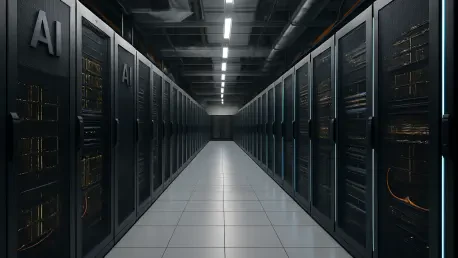In an era where artificial intelligence is reshaping industries at an unprecedented pace, the tech sector is witnessing a monumental surge in infrastructure investments to keep up with soaring demand. Companies are pouring billions into constructing state-of-the-art data centers, essential for powering the complex algorithms and vast computational needs of AI technologies. This wave of development, while promising groundbreaking advancements, also stirs significant concerns over financial sustainability, environmental impact, and community repercussions. Two major players, Anthropic and Microsoft, have recently unveiled ambitious plans to expand their AI capabilities through massive data center projects, setting the stage for a transformative yet challenging chapter in the industry. Their commitments highlight not only the potential of AI to revolutionize business and research but also the intricate balance required to address the broader implications of such rapid growth.
Industry Giants Spearhead AI Infrastructure Growth
Unveiling Anthropic’s Ambitious Expansion Plans
Anthropic, the innovative force behind the AI chatbot Claude, has announced a staggering $50 billion investment to bolster its computing infrastructure with new data centers in Texas and New York. This strategic move, in partnership with Fluidstack, a London-based tech firm, aims to address the escalating demand for AI services from businesses while pushing the boundaries of cutting-edge research. The initiative is poised to create a substantial economic impact, with projections estimating 800 permanent jobs and 2,400 construction roles. However, details regarding specific site locations and the energy sources powering these facilities remain under wraps, raising questions about how these projects will align with sustainability goals. As Anthropic scales its operations, the focus appears to be on maintaining a competitive edge in the AI landscape, ensuring that its infrastructure can support the sophisticated needs of its growing user base.
Beyond the economic benefits, Anthropic’s expansion underscores a broader industry trend of prioritizing infrastructure to meet AI’s computational hunger. The collaboration with Fluidstack is not merely a business transaction but a calculated effort to enhance scalability and efficiency in delivering AI solutions. While the promise of job creation and technological advancement is evident, the lack of transparency on energy usage poses a potential risk, especially as public scrutiny over the environmental footprint of data centers intensifies. The challenge for Anthropic lies in balancing this aggressive growth with responsible practices that mitigate adverse effects on local communities, such as potential spikes in electricity costs. This investment, while a testament to the company’s vision, also serves as a reminder of the complex dynamics at play when scaling AI infrastructure on such a grand scale.
Microsoft’s Strategic Data Center Developments
Microsoft has also entered the fray with its announcement of a new data center in Atlanta, Georgia, dubbed Fairwater 2, which will be linked via a high-speed network to another facility in Wisconsin. Described as a “massive supercomputer,” this project will harness hundreds of thousands of Nvidia chips to drive Microsoft’s AI technologies and support partners like OpenAI. The company’s capital expenditure for AI and cloud infrastructure hit nearly $35 billion in the most recent July-September quarter, with a significant chunk dedicated to advanced chip technology. This bold investment reflects Microsoft’s commitment to maintaining leadership in the AI space, ensuring that its infrastructure can handle the immense processing power required for next-generation applications.
The interconnected nature of Microsoft’s data centers highlights a strategic approach to optimizing performance and scalability across regions. By linking facilities through high-speed networks, the company aims to create a seamless ecosystem that can efficiently manage workloads and deliver robust AI solutions to a global audience. Yet, this ambitious undertaking also brings to light concerns about the financial sustainability of such massive investments, especially in an industry where profitability for AI ventures remains elusive for many. Additionally, the energy demands of operating a supercomputer of this scale could strain local resources, prompting discussions about how Microsoft plans to address environmental and community impacts. This development, while a technological marvel, underscores the need for careful planning to navigate the broader implications of AI infrastructure expansion.
Challenges and Implications of Rapid AI Growth
Financial and Market Sustainability Concerns
The rapid escalation of investments in AI infrastructure by companies like Anthropic and Microsoft raises critical questions about the long-term financial viability of such endeavors. With OpenAI committing an estimated $1.4 trillion over the next eight years and startups in the sector yet to turn a profit, skepticism about a potential investment bubble looms large. Circular deals among AI developers, chip manufacturers, and data center builders further complicate the landscape, casting doubt on whether these massive expenditures will yield sustainable returns. The tech industry’s relentless push to scale capacity, evidenced by over 7.4 gigawatts of data center energy leased in a single fiscal quarter, reflects a high-stakes race where innovation often outpaces profitability considerations.
Beyond the immediate financial risks, the market dynamics of AI infrastructure investment reveal a deeper tension between growth and stability. While companies prioritize building capacity to meet soaring demand, the lack of clear profitability models for many AI ventures fuels apprehension among analysts. The involvement of major players like Oracle and Google in securing data center capacity alongside Microsoft and Fluidstack illustrates the competitive fervor driving this sector. However, without a robust framework to ensure returns on these investments, there is a risk of overextension that could ripple through the industry. Addressing these concerns will require not only strategic foresight but also a willingness to adapt business models to the evolving realities of AI deployment and market expectations.
Environmental and Community Impact Considerations
As AI data centers proliferate, the environmental footprint of these energy-intensive facilities emerges as a pressing concern that the industry must confront. The significant energy consumption required to power hundreds of thousands of chips and maintain operational efficiency often leads to increased electricity costs for surrounding communities, sparking local discontent. Although specific energy sources for Anthropic’s new data centers remain undisclosed, the broader trend of escalating power demands—totaling more than the previous year’s capacity in just one quarter—highlights the urgency of adopting sustainable practices. The tech sector faces mounting pressure to balance its growth ambitions with responsible energy management to minimize ecological harm.
Equally important is the impact on communities hosting these sprawling facilities, where rising utility costs and resource strain can erode public support for such projects. Political sensitivities around energy use have also surfaced, with debates over whether the industry should seek governmental intervention or rely on market self-regulation to address these challenges. The assertion by White House AI official David Sacks that no federal support will be provided emphasizes a belief in competitive resilience, even if major players falter. For companies like Microsoft and Anthropic, navigating these issues will involve not only technological innovation but also transparent dialogue with stakeholders to mitigate tensions. The path forward demands a commitment to sustainable solutions that align industrial growth with environmental stewardship and community well-being.
Reflecting on a Transformative Era
Looking back, the ambitious strides made by Anthropic and Microsoft in expanding AI infrastructure marked a pivotal moment in the tech industry’s evolution. Their investments, totaling billions, underscored a fierce dedication to meeting the computational demands of AI through projects like Anthropic’s $50 billion data centers and Microsoft’s interconnected supercomputer network. These efforts, while showcasing remarkable innovation, also brought to light persistent challenges around financial bubbles, environmental costs, and community impacts that shaped critical discourse.
Moving forward, the focus shifted to actionable strategies for balancing growth with responsibility. Industry leaders began exploring renewable energy integrations and efficiency enhancements to curb environmental footprints. Collaborative frameworks with local governments emerged as a way to address electricity cost concerns, ensuring community benefits from job creation were not overshadowed by resource strain. The legacy of this era pointed to a future where innovation and sustainability could coexist, provided the sector embraced adaptive policies and transparent practices to navigate the complex landscape ahead.









